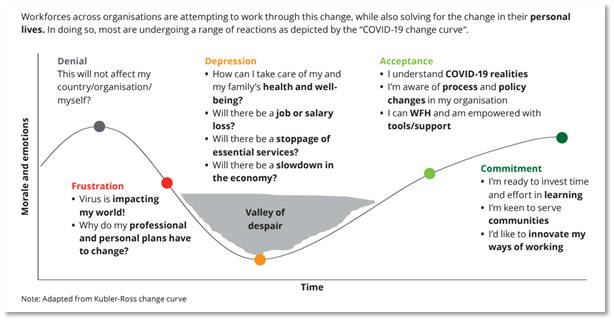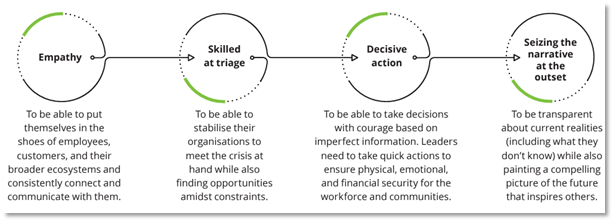Recently a client asked me to prepare some thoughts on how change management has changed during the pandemic. Her team wanted to know how organisations are adjusting their change management approach, what’s working well, and what pitfalls to be careful of.I was thrilled to consolidate my thinking and research into the topic, and now I’m sharing it with you too.
Here’s what organisations need to do to make their changes succeed in 2021 and beyond.
1. Prioritise people
Let’s get meta for a moment.
An organisation is nothing other than a collection of individuals. For an organisation to change, its people must change; and for people to change (that’s us), we need to feel safe, know we have a future, have our questions answered and our concerns addressed.
In the best of times, change can create stress, fear and uncertainty. Add to that the isolation of remote working, the pressure of homeschooling and worries about our children’s wellbeing—it’s a wonder we haven’t all crumbled.
Deloitte articulates this tension brilliantly with this graphic in “Combatting COVID-19 with an Agile Change Management Approach.”

We’re all grappling with challenges and uncertainty at work AND at home.
Over the last 18 months, I’ve been wowed by organisations’ focus on employee wellbeing. From carer’s leave for employees who are homeschooling or lack childcare to virtual “kids clubs” during the afternoon witching hour, companies know that if they don’t focus on people, there won’t be a company anymore.
Yes, these initiatives are costly and they can’t continue forever, but the ethos behind them—you’re not alone, we’re in this together—shouldn’t disappear. It creates a workplace you want to help succeed.
Key questions for change plans:
- What support will people need (time, capacity, new skills) to be successful with the new ways of working? How will you provide this support?
- What personal concerns might people have that could prevent them from engaging with and committing to the change? How can leaders address those personal concerns?
- How can you help people to understand what the future will be like and mean for them?
- How can you involve people so that they feel they’re part of something important and meaningful?
[Dispatch From the Home Front: This Change Went Live Before Anyone Was Ready]
2. Communicate, communicate, communicate
You’ll read this in almost every article on this topic, but it’s so important that I’ll repeat it here: any change you undertake must have a clear and consistent communication strategy.
During disruptive change, focus on what’s changing (the new ways of working) and on what’s staying the same (values and traditions, perhaps).
Your best communicators are your leaders, and they need to be prepared and equipped.
Internally, you’ll need to create channels for expressing emotions and concerns healthily and constructively and be prepared for challenging conversations. It’s not about people just “getting on board,” it’s about helping people to get on board.
Externally, ramp up your support channels, particularly if there is going to be uncertainty or disruption to product availability or service.
Key questions for change plans:
- Who is your audience (internal and external)?
- What messages do they need to hear as they progress up (or slide down) the commitment curve?
- What channels will you use, and with what frequency?
- How are you preparing and equipping your leaders to communicate the change?
- How will you test how the messages are received and understood, and get feedback? How will you respond to that feedback?
(Final words on this topic: please don’t rely on email if the message is important.)
[How to Jumpstart Change Management in 10 Steps]
3. Lead from the front, with heart and mind
While leaders have always been critical to making change succeed, now is the time to emphasize certain attributes of effective change leadership.
Back to the Deloitte report. The authors handily sum up what leaders need to do in this graphic:

“In these testing times, we must support our teams with empathy and optimism,” say the report’s authors. “This will foster the team’s focus on what can be controlled as opposed to being consumed by the chaos. This act alone can make a world of difference.”
Wise words indeed.
Key questions for change plans:
- Which leaders are critically important to this change, and are they prepared and equipped to be change leaders? What development and support do they need?
- What can those leaders say and do to demonstrate commitment and empathy?
[What’s Missing from Leadership Development?]
4. Prioritise, ruthlessly
We love to quote Jim Collins: “If you have more than three priorities, you have none.” At a time when work and home lives have become an amorphous blob—the Year of Blur isn’t over yet—this has never been truer.
Don’t be like Dwight.
In “The ‘New Normal’ Is a Myth. The Future Won’t Be Normal at All,” Bain & Company recommends focusing on simplicity.
When the pandemic kicked in, simplicity became a survival tactic. Complex products, lots of products, and many layers of decision making quickly became unsustainable. Interestingly, many companies Bain studied reported a surprising increase in productivity as a result of cutting out complexity (in many cases, shelving less profitable products) and focusing only on the hero products their customers needed most.
We can extend this to the change demand pipeline.
For too long, organisations have tried to take on too much. I once worked at a company that was undertaking “customer transformation” while implementing a colossal regulatory change that affected every single customer AND some enhancements without which the transformation couldn’t happen.
That was just in technology. Retail had its own list of priority projects, so did customer service, and let’s not forget the whirlwind of BAU.
Somehow it was all meant to just work, even though there wasn’t enough runway to land all the planes.
Prioritising projects means green lighting a small few and saying “no,” “not yet” or “not anymore” to most others. Don’t add a new project without completing or stopping another one. Now may not be the time for a years-long transformation roadmap; let’s focus on solving the biggest problems first.
Key questions for change leaders:
- What are my top three priorities?
- Is this initiative strategically important or a critical business imperative?
Final words on this topic: if we don’t intentionally maintain this simplicity, complexity will creep back in and proliferate.
[Avoid Overload by Improving Capacity for Change & Managing Demand]
5. Adopt a change management methodology
.png?width=424&name=PCI%20wheel%20(2).png)
If you don’t have one already, now is the time! Following a structured approach to managing the people side of change can make a big impact on overall success.
This involves:
- Agreeing on one framework and a common set of processes, tools and measures
- Defining where the capability will reside, how it will be governed and how it will align with other organizational systems, processes and infrastructure
- Building skills
(Does this sound contradictory? On one hand, we’re telling you to do less better; on the other, we’re recommending you adopt a new methodology—a substantial change—if you don’t have one now.
This needs to be done carefully and with consideration: do a network map to identify who needs to be an expert in this new approach and who needs to know a little bit about it. Then consider how you’ll transfer these skills and support people to use them, ideally by starting small—with a few pilot projects—before going big.)
(Learn more about our methodology, People-Centred Implementation, or book in for our next training program.)
6. Build an engaged and adaptable team
Going forward, the capability for change should be recruited for, developed, and rewarded throughout the employee lifecycle. Consciously develop your agents of change up and down the chain.
Key questions for change plans:
- Who are your agents of change today? Are they acting in this capacity consistently? If not, why not?
- Where do you have gaps in change capability? How can you address those gaps?
- How can you use reward and recognition differently, to motivate new behaviours?
This will help you to embed processes and develop people who are motivated and equipped to act.
[#1 Organisational Priority: Adapt to Change]
Conclusion
The truth is that the pandemic will continue to test all of us. We’ll return to the office and start making travel plans, then we’ll have to cancel or reschedule to virtual. We’ll feel relief when kids can go back to school, then dread when it stops again. Rinse and repeat; the feeling of whiplash isn’t going away anytime soon.
Bain & Company is probably right: there isn’t a ‘normal’ to go back to anymore. Big shifts come out of adversity, and we would be foolish to think we can retreat to how things were.
To succeed in our new world, agility, innovation and resourcefulness need to become the new norm, underpinned by leaders leading from the front, focusing on people, being clear about priorities, and rewarding change agents.
Over to you! What would you add to this list?



